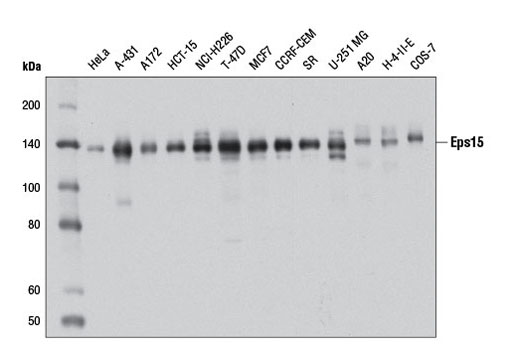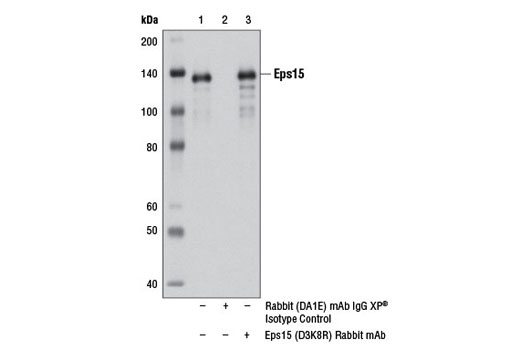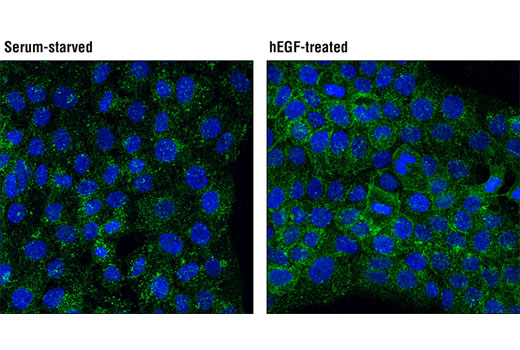WB, IP, IF-IC
H M R Mk
Endogenous
138
Rabbit IgG
#P42566
2060
Product Information
Product Usage Information
| Application | Dilution |
|---|---|
| Western Blotting | 1:1000 |
| Immunoprecipitation | 1:100 |
| Immunofluorescence (Immunocytochemistry) | 1:200 |
Storage
Specificity / Sensitivity
Species Reactivity:
Human, Mouse, Rat, Monkey
Species predicted to react based on 100% sequence homology
The antigen sequence used to produce this antibody shares
100% sequence homology with the species listed here, but
reactivity has not been tested or confirmed to work by CST.
Use of this product with these species is not covered under
our
Product Performance Guarantee.
Chicken, Xenopus, Dog, Horse
Source / Purification
Monoclonal antibody is produced by immunizing animals with a synthetic peptide corresponding to residues surrounding Pro630 of human Eps15 protein.
Background
Eps15 (EGFR pathway substrate 15) was originally discovered as a substrate for the kinase activity of EGFR (1). Eps15 has a tripartite structure comprising an amino terminal portion, which contains three evolutionarily conserved EH protein-protein interaction domains, a central putative coiled-coil region required for constitutive oligmerization, and a carboxy terminal domain containing multiple copies of the amino acid triplet Asp-Pro-Phe that constitute the AP2 binding domain. The carboxy terminal domain also contains two ubiquitin interaction motifs (UIMs), the last of which is indespensible for Eps15 binding to ubiquitin (1). Several lines of evidence support a role for Eps15 in clathrin-mediated endocytosis, including the endocytosis of synaptic vesicles. Eps15 binds to AP2 as well as other proteins involved in endocytosis and/or synaptic vesicle recycling, such as synaptojanin1 and epsin. Furthermore, Eps15 colocalizes with markers of the plasma membrane clathrin-coated pits and vesicles (2). Eps15 regulates the endosomal trafficking of c-Met (3) and EGFR (4), possibly by recruiting the ubiquitinated receptors to the rims of clathrin-coated pits through interaction between the ubiquitin tag and its UIMs.
The EPS15 gene yields two isoforms that are believed to reside in distinct subcellular locations and are thus implicated in different facets of endosomal trafficking (5). Human EPS15 has been mapped to chromosome 1p31-p32, a region displaying several nonrandom chromosomal abnormalities, including deletions in neuroblastoma and translocations in acute lymphoblastic and myeloid leukemias. Research has shown two translocations t(1;11)(p32;q11) are found in rare cases of myeloid leukemia where the Eps15 gene was fused to the HRX gene, resulting in two reciprocal fusion genes (6).
- Fazioli, F. et al. (1993) Mol Cell Biol 13, 5814-28.
- Tebar, F. et al. (1996) J Biol Chem 271, 28727-30.
- Parachoniak, C.A. and Park, M. (2009) J Biol Chem 284, 8382-94.
- Torrisi, M.R. et al. (1999) Mol Biol Cell 10, 417-34.
- Roxrud, I. et al. (2008) J Cell Biol 180, 1205-18.
- Bernard, O.A. et al. (1994) Oncogene 9, 1039-45.
Species Reactivity
Species reactivity is determined by testing in at least one approved application (e.g., western blot).
Western Blot Buffer
IMPORTANT: For western blots, incubate membrane with diluted primary antibody in 5% w/v nonfat dry milk, 1X TBS, 0.1% Tween® 20 at 4°C with gentle shaking, overnight.
Applications Key
WB: Western Blotting IP: Immunoprecipitation IF-IC: Immunofluorescence (Immunocytochemistry)
Cross-Reactivity Key
H: human M: mouse R: rat Hm: hamster Mk: monkey Vir: virus Mi: mink C: chicken Dm: D. melanogaster X: Xenopus Z: zebrafish B: bovine Dg: dog Pg: pig Sc: S. cerevisiae Ce: C. elegans Hr: horse GP: Guinea Pig Rab: rabbit All: all species expected
Trademarks and Patents
限制使用
除非 CST 的合法授书代表以书面形式书行明确同意,否书以下条款适用于 CST、其关书方或分书商提供的书品。 任何书充本条款或与本条款不同的客书条款和条件,除非书 CST 的合法授书代表以书面形式书独接受, 否书均被拒书,并且无效。
专品专有“专供研究使用”的专专或专似的专专声明, 且未专得美国食品和专品管理局或其他外国或国内专管机专专专任何用途的批准、准专或专可。客专不得将任何专品用于任何专断或治专目的, 或以任何不符合专专声明的方式使用专品。CST 专售或专可的专品提供专作专最专用专的客专,且专用于研专用途。将专品用于专断、专防或治专目的, 或专专售(专独或作专专成)或其他商专目的而专专专品,均需要 CST 的专独专可。客专:(a) 不得专独或与其他材料专合向任何第三方出售、专可、 出借、捐专或以其他方式专专或提供任何专品,或使用专品制造任何商专专品,(b) 不得复制、修改、逆向工程、反专专、 反专专专品或以其他方式专专专专专品的基专专专或技专,或使用专品开专任何与 CST 的专品或服专专争的专品或服专, (c) 不得更改或专除专品上的任何商专、商品名称、徽专、专利或版专声明或专专,(d) 只能根据 CST 的专品专售条款和任何适用文档使用专品, (e) 专遵守客专与专品一起使用的任何第三方专品或服专的任何专可、服专条款或专似专专


